- Acne
- Actinic Keratosis
- Aesthetics
- Alopecia
- Atopic Dermatitis
- Buy-and-Bill
- COVID-19
- Case-Based Roundtable
- Chronic Hand Eczema
- Chronic Spontaneous Urticaria
- Drug Watch
- Eczema
- General Dermatology
- Hidradenitis Suppurativa
- Melasma
- NP and PA
- Pediatric Dermatology
- Pigmentary Disorders
- Practice Management
- Precision Medicine and Biologics
- Prurigo Nodularis
- Psoriasis
- Psoriatic Arthritis
- Rare Disease
- Rosacea
- Skin Cancer
- Vitiligo
- Wound Care
Article
Child abuse diagnosis requires careful analysis
Up to 90% of young victims present with cutaneous findings; however, only 8% of the 90% of skin abnormalities due to child abuse are pathognomonic. The diagnosis of child abuse should be evaluated by a multidisciplinary team of expert specialists. Learn what to look for.
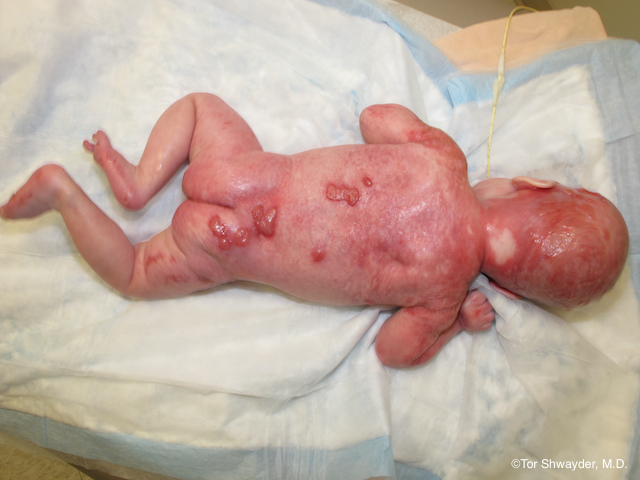
Here, a four-month-old is shown with Hay Wells syndrome which could be mistaken for severe burns.

Due to the nature of this topic and its direct implication across specialties, this article was a collaboration with our sister publication, Contemporary Pediatrics
Dermatologists are among the doctors likely to spot suspected child abuse cases. Why? Researchers have found that skin tells the tale: skin exposes the most easily recognizable physical manifestations of child abuse, up to 90% of young victims present with cutaneous findings.1
However, one should realize that only 8% of the 90% of skin abnormalities due to child abuse are pathognomonic, according to Professor Arnold Oranje, M.D. Ph.D., Rotterdam, the Netherlands, who directed a focus section on skin abnormalities in the differential diagnosis of child abuse at the American Academy of Dermatology annual meeting. Therefore, the diagnosis of child abuse should be evaluated by a multidisciplinary team of expert specialists.
In order for pediatric dermatologists and dermatologists who examine children in their offices to be on the frontlines, helping to protect these kids, they have to keep their eyes open to the possibility, according to Tor Shwayder, M.D., who is triple boarded in pediatrics, dermatology and pediatric dermatology and is director of pediatric dermatology at Henry Ford Hospital, Detroit, Mich. Dr. Shwayder was also a speaker on the AAD’s section on child abuse.
Early diagnosis is key to preventing future abuse or death, according to Dr. Shwayder. An abused child has a 50% chance of being abused again, according to the American Academy of Pediatrics.
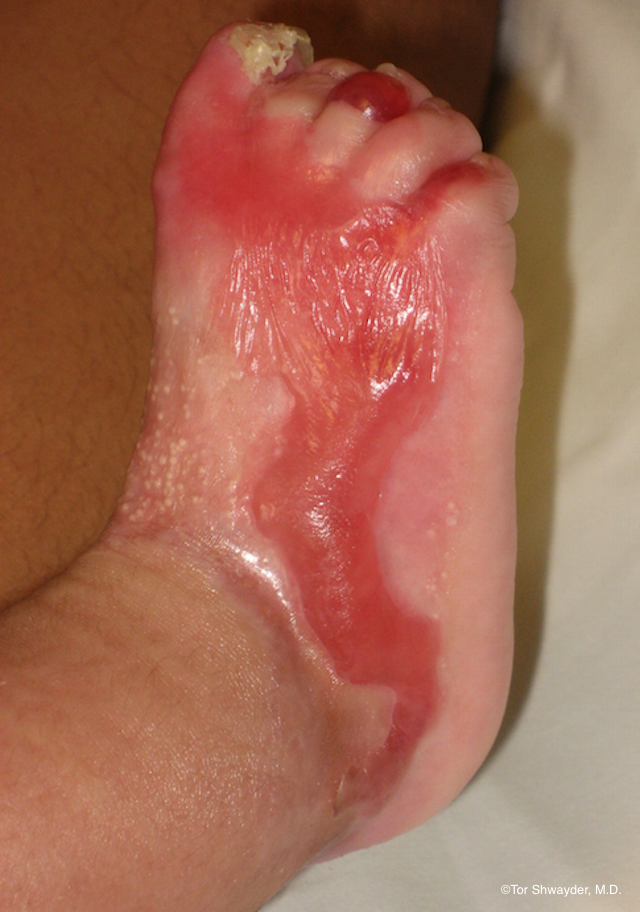
Here, a 21-week-old with non-herlitz epidermolysis bullosa showing a blister on his foot, which could be mistaken for severe burns.


Cutaneous clues: Bruising
Bruises occurring on the knees, elbows and forehead tend to be normal and not a worry. But bruises one wouldn’t expect to see should prompt more questioning. These include bruising on uncommon areas that are away from bone, multiple bruises in clusters and certain patterns (for example, like a whip mark). Abusive bruising patterns include hand prints or grab marks, and bruises that mimic belt buckles, hangars, hair brushes, paddles, spoons, forks and more.
Read: Epidermolysis bullosa presents unique woundcare challenge
“Imagine you’re grabbing a young child. The thumb would be on the front of the arm and your forefingers would be on the back of the arm,” Dr. Shwayder says. “Lip cuts or lip bruises, where someone is forcing the bottle into the mouth and telling the kid to shut up and stop crying, is another cause for concern.”
Other bruises that should be alarming include bruises around the eyes or on the jaw’s tip.
“You rarely [bruise the eye] when you fall because it’s protected by the bone,” says Dr. Shwayder, “and it’s pretty rare to land right on the jaw.”
Dermatologists can differentiate bite marks by other children (in daycare, for example) from adult bite marks by looking at the distance of the canines (the third tooth to the right or left).
“The distance to the canines is more than 3cm in an adult and less than 3 cm in a child,” Dr. Shwayder says, adding that “animal bites are different than human bites. Animal bites tend to tear and they have elongated mouth.”
Careful pattern analysis is therefore necessary, according to Dr. Oranje.
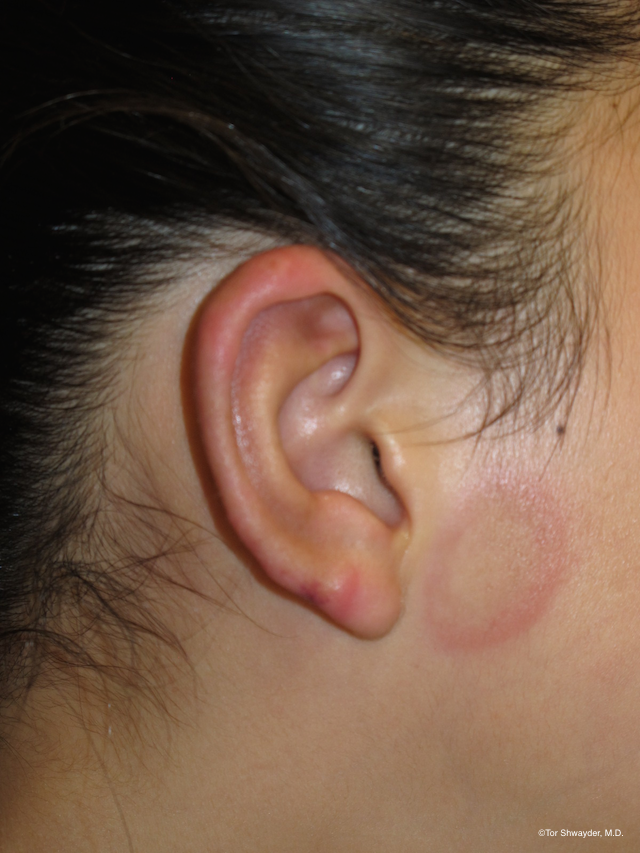
A seven-year-old girl with discoid lupus of the ears, which can be mistaken for bruises resulting from abuse.


Cutaneous clues: Burns
Up to one-fifth of child abuse cases involve burns. And, usually, burns from abuse happen in the first one, two or three years of life, according to a review in the Journal of Trauma in 2002.
Things that should trouble dermatologists are burns that are older than the history would suggest; burns that exist with other injuries, like bruises or fractures; burns that are just a little too symmetrical-like those from cigarettes; and burns located in areas that are unlikely, such as the buttocks.
Recommended: Recognizing cutaneous genetic disorders
“If, for example, you take a kid and force him into a hot bath, the child will clench his buttocks cheeks together, sparing the inner part and burning the outer part,” Dr. Shwayder says.
Burns to the back of the head or the neck are unlikely, unless they’re from child abuse. And burns, in patterns, such as that from the bottom of an iron, are signals of abuse.
“Burn abuse would include scalds, but you have to be careful because sometimes kids do pull things off a stove. I would say if something has been thrown at the child or the child has been emerged in hot liquid, that would look different than if a cup or pot of hot coffee falls on the child,” says Dr. Shwayder.
Hair symptoms and signs
It’s one thing to lose hair because of ringworm, traction alopecia, telogen effluvium or alopecia areata; it’s another to have hair yanked out.
“If someone had their hair dragged and yanked out, or if they’ve been grabbed by the hair and dragged, you will see usually hematomas or hemorrhages develop in the area. And it might be tender and an irregular area of localized hair loss,” Dr. Shwayder says.
Oral clues: Oral injuries
Among the most likely signs of oral abuse are injuries to the outside of the lip. That might be from a bottle being forced into a baby’s mouth or from forced oral sex. Dermatologists should look for unexplained erythema in the palette, especially in the back of the palette, according to Dr. Shwayder.
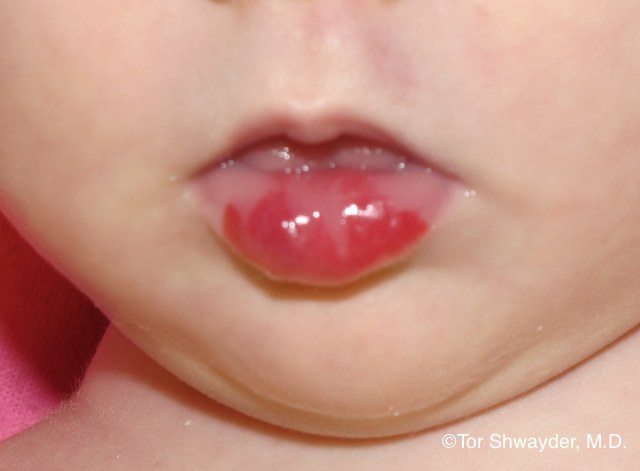
Here, a four-month-old with a lip hemangioma, which can be mistaken as being the result of child abuse.


Genital area clues: Sexual abuse
Sexual abuse manifests in many ways, beyond what’s apparent on the skin. Dermatologists who suspect sexual abuse should probe about a family’s history of encounters with police, as well as a child’s abdominal pain, bed wetting, or refusal to go to the bathroom at all. Sometimes, sexually abused children display inappropriate sexual behavior, sexual play or masturbation-behaviors that are beyond their years. They might have inappropriate sexual knowledge for their age or sexually aggressive behavior.
Dermatologists who suspect sexual abuse should conduct a thorough exam of the child’s genitalia, looking for bruising, lacerations and abrasions, according to Dr. Shwayder. The problem, according to Dr. Oranje, is that pediatric dermatologists often will not find serious abnormalities while the child is being sexually abused; so, a second opinion is always necessary in such cases.
“Dermatologists should familiarize themselves with the normal anatomy of a young boy or girl. And if you see tears or bruises, don’t ignore it,” Dr. Shwayder says.
Some signs of potential sexual abuse are controversial. With as prevalent as it is in society, genital herpes in a child’s diaper area might be innocent, according to Dr. Shwayder. The same goes for condylomata acuminata, according to Dr. Oranje.
Dr. Oranje, who is professor of pediatric dermatology, Skin Hospital Dermicis in Alkmaar, the Netherlands, says there are a few skin manifestations that might confuse even dermatologists.
“Traumatic petechiae misdiagnosed as purpura and lichen sclerosus [are] often misdiagnosed as sexual abuse. Perianal mollusca contagiosa usually have nothing to do with sexual child abuse, while condylomata acuminata sometimes does,” Dr. Oranje says.
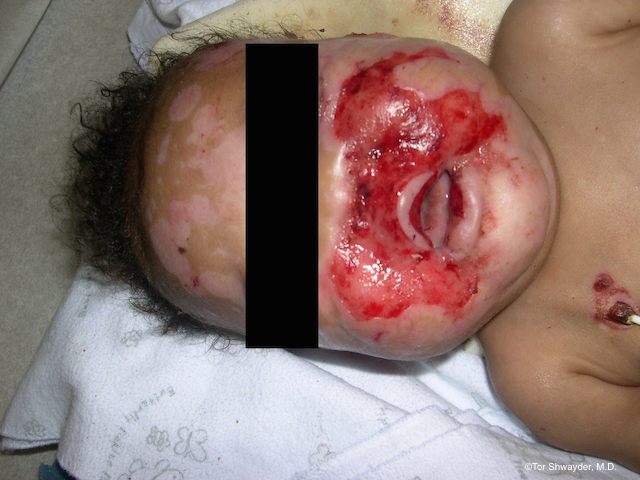
A 26-week-old child with junctional epidermolysis bullosa, which can be mistaken for burns. This child died 2 weeks later.


Taking action
Dermatologists who suspect child abuse should do a full skin exam, with the child undressed. They should document what they see, with words and photographs. They should also include a second opinion and evaluate the child in a multidisciplinary team.
“Take a proper history according to Kipling's principle of the 5Ws (what, when, where, who, why) and try to compose a 100-percent-certain diagnosis, sometimes, also based on histopathological findings,” Dr. Oranje says. “The non-verbal attitude of the child gives also much information. Two examples of non-verbal signs are frozen watchfulness and ostrich behavior [where the child seems to be burying his or her head in the sand].”
When in doubt, it is extremely important to consider asking a colleague to evaluate such cases, according to Dr. Oranje.
Consider recommending a skeletal survey, known as a babygram, to x-ray the child from head to toe.
“When I was an intern in pediatrics at University of Michigan, we did stints at Wayne County General Hospital. A kid came in with odd bruises, and we did the baby gram. The kid had multiple fractured ribs. Multiple fractured ribs is a huge warning, and the parents were eventually put in jail. We picked up just because of that babygram,” Dr. Shwayder says.
Find out which forms are necessary to fill out (in your county or state) for suspected child abuse and fill them out or contact the child’s pediatrician to suggest that doctor fills out the forms.
Know how to get in touch with local child abuse and neglect teams, known as SCAN teams, located at children’s hospitals and in some counties. Dermatologists who suspect child abuse might simply tell the accompanying parents or caregivers that they need to go see Dr. So-and-so at the children’s hospital-directing them to the SCAN team without their full knowledge.
If the person who might be abusing the child is in the office, Dr. Shwayder said he calls the hospital SCAN team into his office. Dermatologists who are offsite from a hospital with a SCAN team can take the parents’ names and numbers and direct them to the local emergency room. Alert the ER about a potential abuse situation. And tell parents you’re very concerned about the child’s condition and that the ER can rule out internal injuries, according to Dr. Shwayder.
Dermatologists play a key role in detecting and, potentially, stopping child abuse, when participating in a multidisciplinary team. Dr. Oranje says, “Dermatologists can read the skin, while other physicians usually have more difficulty doing so, because they are not trained for that. A dermatological evaluation by an expert should always be performed in suspected cases.”
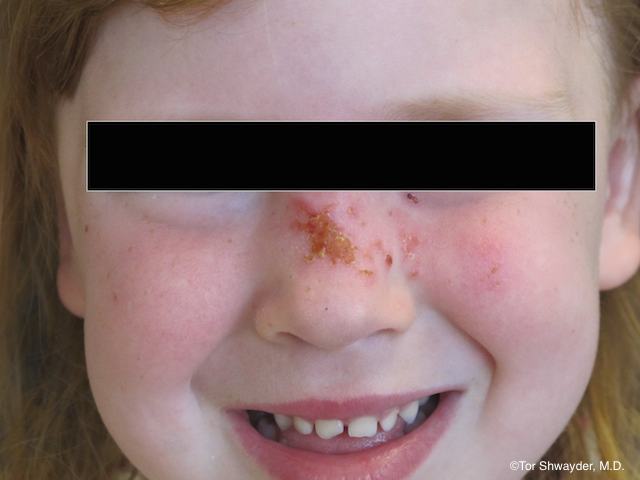
A four-year-old girl with herpes, which could be mistaken as sexually transmitted, and impetigo.


How can you tell?
Of the four major types of child abuse-physical, sexual, emotional and neglect-physical and sexual are likely to present on skin.
There are many clues that should lead dermatologists and others to consider potential child abuse. These are questions to ask:
Does the history match the skin disease? “A kid runs into a pole. Sudden impact with a stationary object causes a linear bruise on his forehead. This makes sense. But if he has fingerprints imprinted on either side of the back of his arms, where someone might have grabbed and shaken the child, that doesn’t make sense,” Dr. Shwayder says.
Do family members or caregivers give conflicting accounts of what happened?
Could the injury have occurred based on the child’s developmental and activity levels?
Was there a delay in seeking care for anything other than a minor injury?
“Usually, parents will be pretty prompt for bringing a kid in for a burn or a laceration that causes bleeding [that isn’t caused by abuse],” says Dr. Shwayder.
Is the child taking a medication that could bruising more likely? Or, for example, does the child have hemophilia, which might help explain bruising.
Has the child been to the emergency room repeatedly for cuts, burns, broken bones, etc.?
Does the pattern of the injury fit something that would be considered abusive?
“Is it a four-year-old with a handprint bruise across his face?” Dr. Shwayder says.
Is the family intact or disorganized? Is there violence among family members? Is there substance abuse? Mental illness affecting the parents or kids? Is there poverty or unemployment? These are all stressors associated with elevated risk of abuse, according to Dr. Shwayder.
Other stressors that can lead to abuse: Are the parents or caregivers young? Does the child cry a lot? Is the child toilet training (unsuccessfully)? Does the child have a birth defect or mental or physical illness?
Another sign that should set off the alarm: Are there severe injuries to the brain, eyes, bones, organs?
Scope of Abuse
In 2013:
About 3.5 million reports were made to child protective services concerning the safety and well-being of about 6.4 million children, according to fiscal year 2013 statistics.
These reports led to an estimated unique count of 679,000 children, who were found to be victims of child abuse or neglect. The unique count counts each child only once, regardless of the number of reports of abuse and neglect.
Four-fifths, or 79.5%, of these children were neglected; 18% were physically abused; and 9% were sexually abused.
In 2013, an estimated 1,520 children died due to abuse or neglect.
Source: Department of Health and Human Services’ 2015 Prevention Resource Guide: Making Meaningful Connections. https://www.childwelfare.gov/pubPDFs/guide.pdf#page=39
For more information
These sources can assist dermatologists in familiarizing themselves with the signs and symptoms of child abuse.
- Peck MD, Priolo-Kapel D. Child abuse by burning: a review of the literature and an algorithm for medical investigations. J Trauma. 2002 Nov;53(5):1013-22. Review. http://www.ncbi.nlm.nih.gov/pubmed/12435962]
- Kos L, Shwayder T. Cutaneous manifestations of child abuse. Pediatr Dermatol. 2006 Jul-Aug;23(4):311-20. http://www.ncbi.nlm.nih.gov/pubmed/16918624
- Ellerstein NS. The cutaneous manifestations of child abuse and neglect. Am J Dis Child. 1979 Sep;133(9):906-9.
- Swerdlin A, Berkowitz C, Craft N. Cutaneous signs of child abuse. J Am Acad Dermatol. 2007 Sep;57(3):371-92. Review. http://www.ncbi.nlm.nih.gov/pubmed/17707148
- Bilo, R.A.C., Oranje, A.P., Shwayder, T., Hobbs, C.J. The Cutaneous Manifestations of Child Abuse and Their Differential Diagnosis. Springer. 2013. http://www.springer.com/us/book/9783642292866
- Brogdon BG, Shwayder T, Elifritz J. Child Abuse and Its Mimic in Skin and Bone. CRC Press. Sept. 20, 2012. http://www.crcpress.com/product/isbn/9781439855355
Reference:
1. Ellerstein NS. The cutaneous manifestations of child abuse and neglect. Am J Dis Child. 1979 Sep;133(9):906-9. http://www.ncbi.nlm.nih.gov/pubmed/?term=american+journal+of+diseases+of+children%2C+1979.+Ellerstein
Newsletter
Like what you’re reading? Subscribe to Dermatology Times for weekly updates on therapies, innovations, and real-world practice tips.











